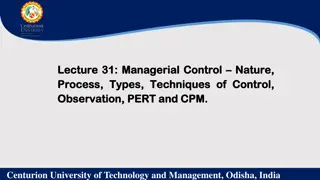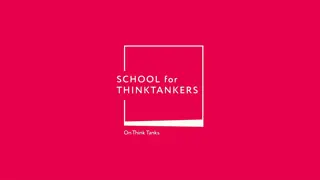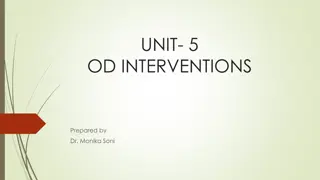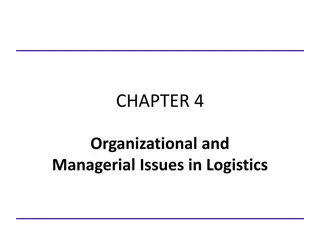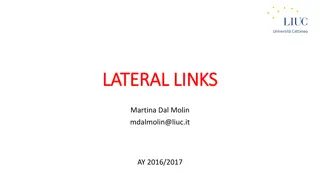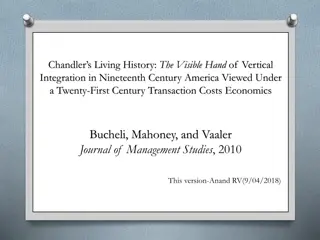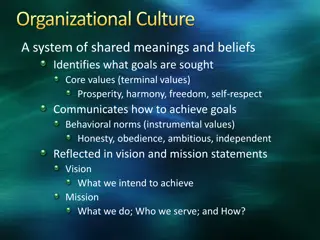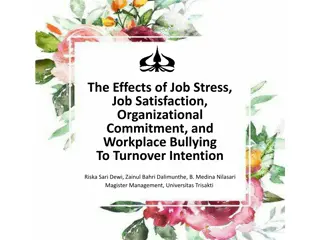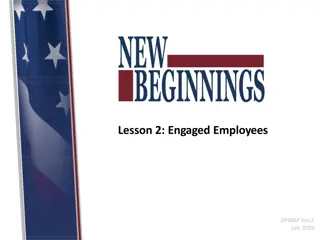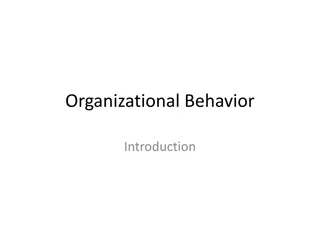Understanding Organizational Control in Business Management
Exploring the concept of control in a business setting, this module delves into the methods, processes, and importance of implementing organizational control. It covers the need for control, different types of control, benefits, and disadvantages, shedding light on how control mechanisms help organizations regulate, guide, and protect their operations.
- Organizational control
- Business management
- Control processes
- Management principles
- Financial controls
Download Presentation

Please find below an Image/Link to download the presentation.
The content on the website is provided AS IS for your information and personal use only. It may not be sold, licensed, or shared on other websites without obtaining consent from the author. Download presentation by click this link. If you encounter any issues during the download, it is possible that the publisher has removed the file from their server.
E N D
Presentation Transcript
Principles of Management Module 15: Control
Module Learning Outcomes Explain the methods and need for control within an organization 15.1: Explain what control means in a business setting and why it is needed 15.2: Explain the basic control process and monitoring points 15.3: Describe the different levels and types of control 15.4: Explain the need for a balanced scorecard 15.5: Explain the use of financial and nonfinancial controls in business
Learning Outcomes: Control in the Business Setting 15.1: Explain what control means in a business setting and why it is needed 15.1.1: Explain what control means in a business setting 15.1.2: Describe the benefits and costs of organizational control
What Does Control Mean in the Business Setting? Control is device or mechanism used to regulate or guide operation of a machine, apparatus, or system Control is in a business setting and involves the processes that regulate, guide, and protect an organization One type of control- set of financial policies Most common style is top-down control- decisions are made by high- level executives and passed down
Implementing Organizational Control Organizational control means developing rules, procedures, or other protocols for directing the work of employees and processes Important because it helps identify errors and deviation from standards Benefits: improved communication, financial stability, increased productivity, help in meeting goals, etc. Employee morale may be higher when workers see that management is paying attention and knows what it is doing Example: Toyota
Disadvantages Some systems can be very expensive so management must weigh the cost versus the benefit for each control Control mentality can lead to overstaffing and unsustainable costs for some businesses Maintaining controls is also an expense Controls can become blind spot for management Rigid implementation may lead to a slowdown in the operation of the business
Learning Outcomes: The Control Process 15.2: Explain the basic control process and monitoring points 15.2.1: Explain the basic control process 15.2.2: Differentiate between feedback, proactive, and concurrent controls
Understanding The Control Process Setting performance standards Measuring actual performance Comparing actual performance with standards or goals Analyzing deviations Taking corrective action
Timing of Controls Controls categorized according to time in which process or activity occurs Controls related to time include: Feedback Proactive Concurrent Advantages and Disadvantages of each
Feedback Occurs after an activity or process is completed Example: Evaluating team s progress by comparing production standard to actual production output Example: When a sales goal is set, sales team works to reach goal for next three months, followed by review period Disadvantage- modifications can be made only after a process has already been completed or an action has taken place
Proactive Control Involves anticipating trouble rather than waiting for a poor outcome and reacting afterward About prevention or intervention Example: When an engineer performs tests on braking system of prototype vehicle before it is moved on to be mass produced Looks forward to problems that could reasonably occur and devises methods to prevent problems Disadvantage: Can t control unforeseen and unlikely incident
Concurrent Control Monitoring takes place during process or activity May be based on standards, rules, codes, and polices Example: Fleet tracking by GPS to allow managers to monitor company vehicles Example: Keen Media tries to reduce employee inefficiency by monitoring Internet activity
Practice Question 1 In the Lean/Agile management process, a workflow staple is the Daily Standup where each team member quickly outlines what they are working on. This would be an example of: 1. Feedback control. 2. Proactive control. 3. Concurrent control.
Practice Question 2 Also from the Lean/Agile handbook is the process called post-mortem where the team evaluates their 2-week progress. This would be an example of: 1. Feedback control. 2. Proactive control. 3. Concurrent control.
Learning Outcomes: Levels and Types of Control 15.3: Describe the different levels and types of control 15.3.1: Differentiate between strategic, operational, and tactical controls 15.3.2: Differentiate between top-down, objective, and normative control
Strategic Control Involves monitoring a strategy as it is being implemented, evaluating deviations, and making necessary adjustments May involve reassessment of strategy due to unforeseen event Implementing strategy often involves series of activities that occur Also involves monitoring internal and external events Errors are major- failing to anticipate customers reaction to competitor s new product
Operational Control Involves control over intermediate term operations and processes but not business strategies Ensure that activities are consistent with established plans Mid-level management uses operational controls for intermediate-term decisions When performance doesn t meet standards, managers enforce actions such as training, discipline, motivation, or termination Focuses more on internal sources of information and affects smaller units or aspects of organization Errors may mean failing to complete project on time
Tactical Control Tactic is a method that meets specific objective of an overall plan Emphasizes current operations of an organization Managers determine what various parts of organization must do for organization to be successful in the near future Strategic control always comes first, followed by operations, and then tactics
Top-Down Controls Means use of rules, regulations, and formal authority Includes budgets, statistical reports, and performance appraisals Advantages: Employees can spend their time performing their job duties instead of discussing direction of the company and offering input into development of new policies Disadvantages: lower levels are in touch with customers and recognize new trends or new competition earlier than senior management- may discourage employees from sharing information or ideas up chain of command
Objective and Normative Control Objective control based on facts that can be measured and tested- measures observable behavior Output control is another form of objective control Normative control govern behavior through accepted patterns of action rather than written policies and procedures Uses values and beliefs Reflects organization s culture
Learning Outcomes: The Need for a Balanced Scorecard 15.4: Explain the need for a balanced scorecard 15.4.1: Identify the four typical components of the balanced scorecard 15.4.2: Explain the need for a balanced scorecard
The Balanced Scorecard More than 50% of large U.S. firms use the balanced scorecard- many large firms over the world use the balanced scorecard in business operations Reaction to earlier mistakes driven by narrow focus on financial results Adds goals for company s customers, internal quality, and learning and growth
Balanced Scorecard Components Communicate goals, align daily tasks with strategies, prioritize projects, measure performance, monitor progress 4 different perspectives: Learning and growth: involves culture of a company Internal business processes: focuses on how well company is running Customers perspective: often measured by surveying existing customers Financials: company must succeed financially to continue operating
Why a BSC Is Needed? Without balanced scorecard, executives focus on only one or a few aspects of the organization Company may be doing well financially but performing poorly in another area For example, company may exceed customer expectations related to product quality, corporate social responsibility, and customer service Forces managers to look at company as a whole to measure performance and more accurately determine company s overall state
Learning Outcomes: Financial and Nonfinancial Controls 15.5: Explain the use of financial and nonfinancial controls in business 15.5.1: Explain the use of budgets to both control and delegate authority 15.5.2: Explain the use of financial ratios (comparisons) as a control method 15.5.3: Explain the benefits of quality management 15.5.4: Explain the costs of quality management
Budgetary Control Standard financial reports are statement of cash flows, balance sheet, income statement, financial ratios, and budgets Budget sets limit on spending and is a method of control used to help organizations achieve goals Following a budget requires discipline Budgets can also be used to delegate authority
Financial Ratios Managers use ratios to analyze elements such as debt, equity, efficiency, and activity Debt ratios compares organization s debt to its assets- higher the ratio, the more leveraged the company is Key to understanding ratios is comparing them to relevant benchmarks- debt ratio for manufacturing company is around 50% but in bank is 92% Analyzing financial ratios helps managers determine financial health company
Practice Question 3 The following ratios would be helpful for which of the following industries? DIO = 365 / (Inventory Turnover: cost of sales during period /average inventory balance during the same period) DSO = 365 / (credit sales during period /average accounts receivable balance during the same period) DPO = 365 / (cost of sales during period /average accounts payable balance during the same period) 1. Retail 2. Manufacturing 3. Banking 4. Hospitality
Quality Management Involves controlling, monitoring, and modifying tasks to maintain desired level of quality Benefits helps companies please customers so company can maintain good reputation, gain competitive edge, and ultimately make a profit Company also saves both time and money by reducing defects Costs regulations are type of control that society puts on companies Drives managers great lengths to please customers which can become quite expensive Purchase new software/equipment, hire employees, conduct studies, and consult with experts
Quick Review What does control mean in a business setting? What are the benefits and costs of organizational control? What is the basic control process? Can you differentiate between feedback, proactive, and concurrent controls? Can you differentiate between strategic, operational, and tactical controls? Between top-down, objective, and normative control
More Quick Review Are you able to identify the four typical components of the balanced scorecard? Are you able to correctly explain the need for a balanced scorecard? What is the use of budgets to both control and delegate authority? What is the use of financial ratios as a control method? What are the benefits of quality management? What are the costs of quality management?
Class Discussion You are one of the founders of a startup in the logistics industry. What would be the first control mechanisms that you would put in place to get your business started successfully?







